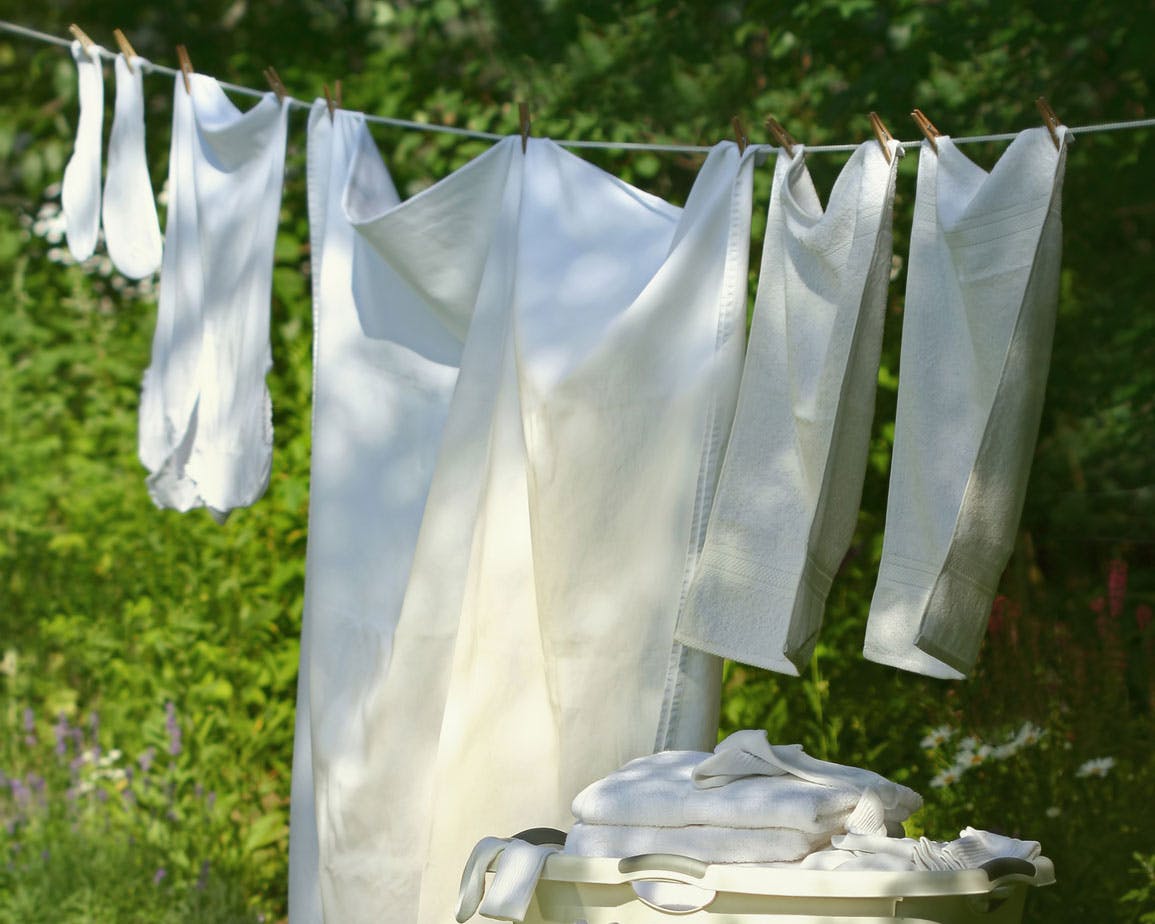Why Line-Drying Sheets is Better for You and the Environment
For fresh, crisp sheets, thread count matters far less than how you dry your bedding.
I grew up with line-dried, budget-friendly, cotton percale sheets, which stayed cool and crisp on sweltering Virginia summer nights. When I left home, I discovered dryers leave bedding mushy and bland by comparison; my finely woven sheets clung to my skin. No laundry product could replicate that bracingly fresh, almost-stormy scent of line-dried bedding. Then, in a tiny apartment in Budapest — where dryers still weren’t common — I learned that neither yards nor balconies were prerequisites for the line-dried bedding of my dreams.
So, what makes that distinctive line-dried scent? Dirty laundry gets its aroma from chemicals, called volatile organic compounds (VOCs), produced by bacteria feeding on sweat and skin cells. Washing machines don’t completely remove these chemicals, but good ventilation speeds up their evaporation and dispersal. Ozone and oxygen outdoors even oxidize dimethyl disulfide — a pungent and oniony VOC found on clothing — into an odorless substance. Fresh air also leaves behind the unique flavor of the day’s breezes.
If you’re new to line-drying, bedding is an easy entry point: unlike socks and undies — which need individually pinning — it takes barely more time to throw a sheet over a clothesline than to toss it in the dryer.
In a tiny apartment in Budapest, I learned neither yards nor balconies were prerequisites for the line-dried bedding of my dreams.
The energy savings are significant. The average dryer pulls 2790 watts of electricity — equivalent to switching on 46 incandescent light bulbs for the duration of the dryer’s cycle. Although most home appliances have become dramatically more efficient in recent decades, North American clothes dryers have barely evolved since the ’90s, according to National Resources Canada. Dryers now use nearly as much energy as our fridges, dishwashers, and washing machines combined.
Getting Started
If you’re new to line-drying, summer is the perfect time to start. In Portland, where I live, laundry can dry in less than an hour at the hottest part of the day — and with more than 15 hours of daylight in June, there’s no shortage of opportunities.
Scope out the sunniest, breeziest spots around your home. In the Pacific Northwest, hot afternoons and ocean winds make southerly and westerly corners ideal. But, in areas prone to afternoon thunderstorms, you’re safer setting up your laundry on the eastern side of your home to catch morning sun, or hanging your wash under an awning or porch. In dry climates, laundry can even dry overnight. For year-round drying, a line hanging east to west will maximize exposure to the low winter sun. If sunny days are rare, an indoor drying rack near a sunny window or heat vent may work best.
Where I live, laundry can dry in less than an hour at the hottest part of the day.
Your local hardware store probably has sturdy hooks or eye bolts, weather-resistant clothesline for sale by the yard, and wooden spring clothespins. If you’re stringing laundry from a high porch, you may also need pulleys. Hang the line out of flapping range of nearby buildings — on a windy day, light sheets can blow nearly horizontal — and high enough to keep laundry off the ground and away from pets’ fur.
Tighten the line as much as you can; the weight of wet laundry will sag it significantly. Parallel lines outdoors shouldn’t be closer than six inches so larger items don’t blow into one another. For very small spaces, tall collapsible floor racks or high wall-mounted racks take up less room and allow bedding to hang folded in half.
Hanging Wash
Queen and larger sheets work best draped lengthwise down the middle. If the material is thin, you can fold them double to save space. Fitted sheets should have their pockets facing out, and dry most quickly when hung asymmetrically with one third on one side of the line and two thirds on the other, so the slower-drying pockets aren’t next to each other.
On a shorter rack, a sheet can be folded lengthwise and woven through the rungs. Be cautious with heavy flannel sheets; they won’t dry quickly enough indoors to prevent mildew unless the room is well-ventilated.
Consumerist culture tells us spending money is the path to comfort, but sustainability has its own sensual delights.
Sunlight is powerful! Ultraviolet rays can even disinfect water. But they can also fade fabric that’s on the line too long. During allergy season, I toss my line-dried laundry in the dryer for 10 minutes to remove pollen, but some allergy sufferers may require an indoor rack.
Consumerist culture tells us spending money is the path to comfort, but sustainability has its own sensual delights. Short of pinning a cool breeze to your bed, nothing smells sweeter than fresh line-dried cotton.
Print Issue: Summer/Fall 2019
Print Title: Line-Dried Luxury
